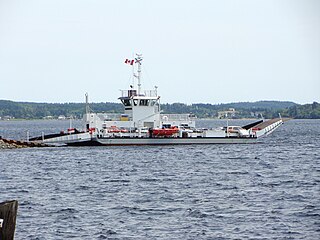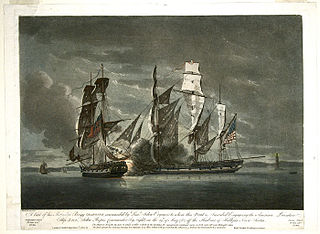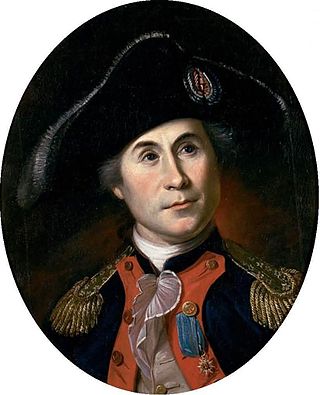
Sambro is a rural fishing community on the Chebucto Peninsula in the Halifax Regional Municipality, in Nova Scotia, Canada. It is on the Atlantic Ocean at the head of Sambro Harbour, immediately west of the entrance to Halifax Harbour. Sambro is at the end of Route 306.

The LaHave River is a 97 km (60 mi) river in Nova Scotia, Canada, running from its source in Annapolis County to the Atlantic Ocean. Along its way, it splits the communities of LaHave and Riverport and runs along the Fairhaven Peninsula and bisects the town of Bridgewater flowing into the LaHave River estuary. Tides affect water levels for about 20 km up the river. There are a number of tourist attractions along the river, and it is also well-used for recreational sailing. As well as two bridges at Bridgewater, the river can be crossed by a cable ferry at the Community of LaHave.

The Raid on Lunenburg occurred during the American Revolution when the US privateer, Captain Noah Stoddard of Fairhaven, Massachusetts, and four other privateer vessels attacked the British settlement at Lunenburg, Nova Scotia on July 1, 1782. The raid was the last major privateer attack on a Nova Scotia community during the war.

The Battle off Halifax took place on 28 May 1782 during the American Revolutionary War. It involved the American privateer Jack and the 14-gun Royal Naval brig HMS Observer off Halifax, Nova Scotia. Captain David Ropes commanded Jack, and Lieutenant John Crymes commanded Observer. The battle was "a long and severe engagement" in which Captain David Ropes was killed.

Captain Noah Stoddard (1755–1850) of Fairhaven, Massachusetts was an American privateer who distinguished himself during the American Revolution by leading the Raid on Lunenburg (1782). In the raid, Stoddard led four other privateer vessels and attacked the British settlement at Lunenburg, Nova Scotia on July 1, 1782. In Nova Scotia, the assault on Lunenburg was the most spectacular raid of the war.

HMS Blonde was a 32-gun fifth-rate warship of the British Royal Navy captured from the French in 1760. The ship wrecked on Blonde Rock with American prisoners on board. An American privateer captain, Daniel Adams, rescued the American prisoners and let the British go free. The captain's decision created an international stir. Upon returning to Boston, the American privateer was banished for letting go the British crew and he and his family became Loyalist refugees in Nova Scotia.

Dr. Jonathan Prescott was a British officer who fought at the Siege of Louisbourg (1745), became the Captain of the militia at Chester, Nova Scotia and later was involved with the Raid on Chester, Nova Scotia (1782). He was the father of Charles Ramage Prescott.
George Wait Babcock was one of the most successful American privateers of the American Revolution, capturing 28 British vessels while in command of the Marlborough. He also led the land forces in the Raid on Lunenburg (1782) during the American Revolution.

The Battle of Blomidon took place on 21 May 1781 during the American Revolutionary War. The naval battle involved three armed U.S. privateer vessels against three Nova Scotian vessels off Cape Split, Nova Scotia. American Privateers caught two Nova Scotia Vessels. The first Nova Scotia vessel was re-captured by Lieut Benjamin Belcher. The second Nova Scotia vessel was overtaken by the captured crew under the command of Captain Bishop. The privateers were taken to Cornwallis and put on trial.

The Raid on Annapolis Royal took place on 29 August 1781 during the American Revolutionary War. The raid involved two American privateers - the Resolution and the Reprisal - attacking and pillaging Annapolis Royal, Nova Scotia in revenge of the defeat of the Penobscot Expedition. The privateers took captive the commander of the militia John Ritchie, described as the "Governor of Annapolis." One historian described it as "one of the most daring and dramatic raids upon Nova Scotia."

The Raid on Canso took place on 22 September – November 22, 1776 during the American Revolutionary War. The raid involved American Continental Navy captain John Paul Jones attacking Canso, Nova Scotia and the surrounding fishing villages.

The Battle of Liverpool took place on 24 April 1778 during the American Revolutionary War. The raid involved the British vessel HMS Blonde and the French 24-gun frigate Duc de Choiseul.

The Raid on Saint John took place on 27 August 1775 during the American Revolutionary War. The raid involved American privateers from Machias, Commonwealth of Massachusetts Bay attacking Saint John, Nova Scotia on the northeast shore of the Bay of Fundy(in present day New Brunswick). The privateers intended to stop the export of supplies being sent to the loyalists in Boston. This raid was the first hostile act committed against Nova Scotia and it resulted in raising the militia across the colony.
The Raid on Yarmouth took place on 5 December 1775 during the American Revolutionary War. The raid involved American Privateers from Salem, Massachusetts attacking Yarmouth, Nova Scotia at Cape Forchu. The privateers intended to stop the export of supplies being sent from Nova Scotia to the loyalists in Boston.

The Battle off Yarmouth took place on 28 March 1777 during the American Revolutionary War off the coast of Yarmouth, Nova Scotia. The battle is the first American armed vessel to engage the British Navy. The British vessel HMS Milford forced the American USS Cabot aground and the American crew escaped among the inhabitants of Yarmouth.

The Province of Nova Scotia was heavily involved in the American Revolutionary War (1776–1783). At that time, Nova Scotia also included present-day New Brunswick until that colony was created in 1784. The Revolution had a significant impact on shaping Nova Scotia, "almost the 14th American Colony". At the beginning, there was ambivalence in Nova Scotia over whether the colony should join the Americans in the war against Britain. Largely as a result of American privateer raids on Nova Scotia villages, as the war continued, the population of Nova Scotia solidified their support for the British. Thousands of Loyalist refugees fled to Nova Scotia during the war, and many were resettled in the region after the signing of the 1783 Treaty of Paris as "United Empire Loyalists".
The Battle off Halifax took place on 10 July 1780 during the American Revolutionary War. The British privateer Resolution fought the American privateer Viper and heavy casualties were suffered by both sides. The battle was "one of the bloodiest battles in the history of privateering.... a loss of 51 lives in a single battle was virtually unheard of."

The American frigate USS Hancock was captured by the British Royal Navy in a 1777 naval battle during the American Revolutionary War. The two highest ranking naval officers of the war battled each other off the coast of Nova Scotia. HMS Rainbow, under the command of British Admiral George Collier, captured USS Hancock, under the command of Captain John Manley.

The Raid on Chester occurred during the American Revolution when the US privateer, Captain Noah Stoddard of Fairhaven, Massachusetts, and four other privateer vessels attacked the British settlement at Chester, Nova Scotia on 30 June 1782. The town was defended by Captain Jonathan Prescott and Captain Jacob Millett.

Captain David Ropes was a notable American privateer from Salem, Massachusetts who fought in numerous naval battles during the American Revolutionary War. He was taken prisoner twice during the war and then killed in the Battle off Halifax (1782).













